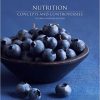Test Bank for Nutrition Concepts and Controversies 13th Edition By by Frances Sienkiewicz Sizer
Chapter 3 – The Remarkable Body
Chapter Learning Objectives
3.1 Describe the levels of organization in the body, and identify some basic ways in which nutrition supports them.
3.2 Describe the relationships between the body’s fluids and the cardiovascular system and their importance to the nourishment and maintenance of body tissues.
3.3 Summarize the interactions between the nervous and hormonal systems and nutrition.
3.4 State how nutrition and immunity are interrelated, and describe the importance of inflammation to the body’s health.
3.5 Compare the terms mechanical digestion and chemical digestion, and point out where these processes occur along the digestive tract with regard to carbohydrate, fat, and protein.
3.6 Name some common digestive problems and offer suggestions for dietary alterations that may improve them.
3.7 Identify the excretory functions of the lungs, liver, kidneys, and bladder, and state why they are important to maintain normal body functioning.
3.8 Identify glycogen and fat as the two forms of nutrients stored in the body, and identify the liver, muscles, and adipose tissue as the body tissues that store them.
3.9 Define the term moderate alcohol consumption, and discuss the potential health effects, both negative and positive, associated with this level of drinking.
True/False Items
1. Cells are organized into tissues that perform specialized tasks and tissues, in turn, are grouped together to form whole organs.
2. Body fluids supply the tissues continuously with energy, oxygen, and nutrients, including water.
3. Chewing food for an extended time provides additional advantages to digestion.
4. Timing of meals is important because the digestive tract is unable to digest food at certain times.
5. Some nutrients are stored in the body in much smaller quantities than others are.
6. Some vitamins are stored in the body without limit, even if they reach toxic levels.
7. The pancreas releases glucagon to remove glucose from blood and store it in muscles.
8. The hypothalamus in the brain monitors many body conditions, including the availability of nutrients and water.
9. Inflammation is the immune system’s normal, healthy response to cell injury.
10. Frequent use of laxatives is an effective way to prevent constipation.
11. Waste materials dissolved in water are collected by the kidneys and become concentrated as urine.
Comprehension-Level Multiple-Choice Items
1. Cells can best be described as:
a. the basis of the body’s design.
b. the vital components of foods.
c. self-contained living entities.
d. building blocks of the body.
2. Among the cells’ most basic needs are _____ and the oxygen with which to burn it.
a. water
b. essential nutrients
c. building blocks
d. energy
3. The first principle of diet planning is that the foods we choose must provide energy and the essential nutrients, including:
a. water.
b. fuel.
c. oxygen.
d. carbon dioxide.
4. Which of the following determines the nature of the cell’s work?
a. organs
b. mutations
c. red blood cells
d. genes
5. Cells lining the digestive tract replace themselves every:
a. 3 days.
b. 2 weeks.
c. 4 months.
d. 12 months.
6. Which of the following cells normally replace themselves once every few years?
a. muscle
b. skin
c. digestive tract
d. red blood
7. Which of the following types of cells do not reproduce, and if damaged by injury or disease, are lost forever?
a. skin cells
b. red blood cells
c. muscle cells
d. brain cells
8. The body’s circulating fluids include:
a. intracellular fluid.
b. blood.
c. lymph.
d. a and b
e. b and c
9. The blood picks up oxygen and releases carbon dioxide in the:
a. heart.
b. liver.
c. digestive system.
d. lungs.
10. Which of the following has the special task of chemically altering absorbed materials to make them better suited for use by other tissues?
a. liver
b. pancreas
c. stomach
d. small intestine









Reviews
There are no reviews yet.